

30 Questions to Ask Yourself Before You Die. {Via studioflowerpower on etsy} “Rather than money, than fame, than love…give me truth.” ~ Thoreau I woke up this morning and my life clock marked 30. My first sleep-deprived idea was to pack a small suitcase, get on the first train, move to another country, change my name, change my hair color (or get plastic surgery if needed), and start from scratch. When I don’t know how to deal with life, I hide sometimes. 5 Timeless Books of Insight on Fear and the Creative Process. By Maria Popova From Monet to Tiger Woods, or why creating rituals and breaking routines don’t have to be conflicting notions.
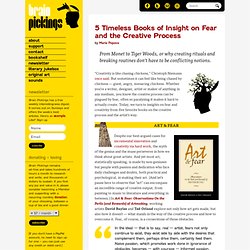
“Creativity is like chasing chickens,” Christoph Niemann once said. But sometimes it can feel like being chased by chickens — giant, angry, menacing chickens. Whether you’re a writer, designer, artist or maker of anything in any medium, you know the creative process can be plagued by fear, often so paralyzing it makes it hard to actually create. A Map of Woman’s Heart: Rare Vintage Gem from the 1800s. By Maria Popova From coquetry to selfishness, or what the Sea of Wealth has to do with the City and District of Love.
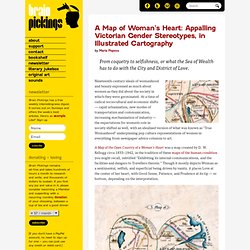
Nineteenth-century ideals of womanhood and beauty expressed as much about women as they did about the society in which they were germinated. At a time of radical sociocultural and economic shifts — rapid urbanization, new modes of transportation and communication, increasing mechanization of industry — the expectations for women’s role in society shifted as well, with an idealized version of what was known as “True Womanhood” underpinning pop culture representations of women in everything from newspaper advice columns to art.
A Map of the Open Country of a Woman’s Heart was a map created by D. W. Be Like Water: The Philosophy and Origin of Bruce Lee’s Famous Metaphor for R... Brené Brown on Vulnerability, Human Connection, and the Difference Between Em... Goethe on the Psychology of Color and Emotion. Happy 130th Birthday, A. A. Milne: "Happiness" and the Origin of Winnie-the-Pooh. By Maria Popova On rainy days and the simplicity of happiness.
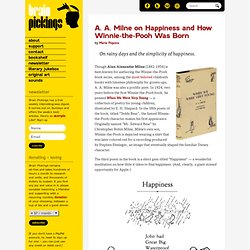
Though Alan Alexander Milne (1882-1956) is best-known for authoring the Winnie-the-Pooh book series, among the most beloved children’s books with timeless philosophy for grown-ups, A. A. Milne was also a prolific poet. How to Write with Style: Kurt Vonnegut’s 8 Keys to the Power of the Written Word. Find a Subject You Care About Find a subject you care about and which you in your heart feel others should care about.
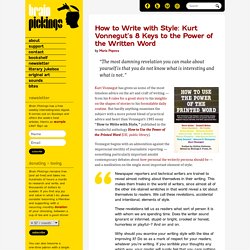
It is this genuine caring, and not your games with language, which will be the most compelling and seductive element in your style. I am not urging you to write a novel, by the way — although I would not be sorry if you wrote one, provided you genuinely cared about something. A petition to the mayor about a pothole in front of your house or a love letter to the girl next door will do. Do Not Ramble, Though I won’t ramble on about that. Keep It Simple As for your use of language: Remember that two great masters of language, William Shakespeare and James Joyce, wrote sentences which were almost childlike when their subjects were most profound.
Simplicity of language is not only reputable, but perhaps even sacred. Have the Guts to Cut. Internal Time: The Science of Chronotypes, Social Jet Lag, and Why You're So ... By Maria Popova Debunking the social stigma around late risers, or what Einstein has to do with teens’ risk for smoking.
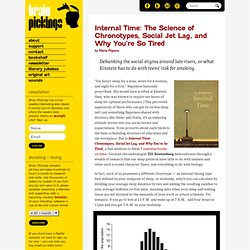
“Six hours’ sleep for a man, seven for a woman, and eight for a fool,” Napoleon famously prescribed. (He would have scoffed at Einstein, then, who was known to require ten hours of sleep for optimal performance.) Janis Joplin on Creativity and Rejection: Her Lost Final Interview, Rediscove... Modern Masterpieces of Comedic Genius: The Art of the Humorous Amazon Review,... By Maria Popova From scientific miracles to literary criticism, by way of bodily functions and failures of common sense.

Many moons ago, I wrote about the art of the humorous Amazon review as a modern masterpiece of parodic genius, embodying Arthur Koestler’s seminal “bisociation” theory of how humor and creativity work. It turns out this peculiar micro-genre of satire is surprisingly expansive — here is a sequel-selection of amusing, absurd, preposterous, and plain funny reviews, spanning everything from literary classics to industrial equipment. Some take advantage of Amazon’s tendency to mash up the brand name and product description in the same title field, which often makes for some inherently funny propositions — like the Pelican 1510-004-110 Case with Padded Dividers, Black, on which “Teddy Picker” pounces elegantly: Some are doubly amusing not only by virtue of the humorous review but also by the sheer absurdity of why such an item would be sold on Amazon in the first place.
Much Loved: Portraits of Beloved Childhood Teddies. By Maria Popova What a forty-something bear might know about the meaning of life.
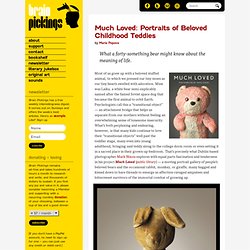
Most of us grew up with a beloved stuffed animal, to which we pressed our tiny noses as our tiny hearts swelled with adoration. Mine was Laika, a white bear semi-explicably named after the famed Soviet space dog that became the first animal to orbit Earth. Psychologists call this a “transitional object” — an attachment bridge that helps us separate from our mothers without feeling an overwhelming sense of lonesome insecurity. What’s both perplexing and endearing, however, is that many kids continue to love their “transitional objects” well past the toddler stage, many even into young adulthood, bringing said teddy along to the college dorm room or even setting it in a sacred place in their grown-up bedroom.
On a Beam of Light: The Story of Albert Einstein, Illustrated by the Great Vl... By Maria Popova The charming visual tale of an introverted little boy who grew up to become the quintessential modern genius.
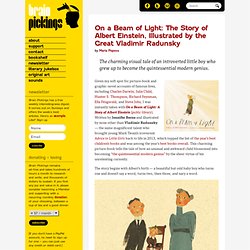
Given my soft spot for picture-book and graphic-novel accounts of famous lives, including Charles Darwin, Julia Child, Hunter S. Thompson, Richard Feynman, Ella Fitzgerald, and Steve Jobs, I was instantly taken with On a Beam of Light: A Story of Albert Einstein (public library). Written by Jennifer Berne and illustrated by none other than Vladimir Radunsky — the same magnificent talent who brought young Mark Twain’s irreverent Advice to Little Girls back to life in 2013, which topped the list of the year’s best children’s books and was among the year’s best books overall.
This charming picture-book tells the tale of how an unusual and awkward child blossomed into becoming “the quintessential modern genius” by the sheer virtue of his unrelenting curiosity. Instead, he “just looked around with his big curious eyes,” wondering about the world. Donating = Loving. Salvador Dalí Illustrates Alice in Wonderland, 1969. Six Famous Thought Experiments, Animated in 60 Seconds Each. By Maria Popova From the fine folks at the Open University comes 60-Second Adventures in Thought, a fascinating and delightfully animated series exploring six famous thought experiments.

The Paradox of the Tortoise and Achilles comes from Ancient Greece and explores motion as an illusion: Sleep and the Teenage Brain. By Maria Popova How a seemingly simple change can have a profound effect on everything from academic performance to bullying.
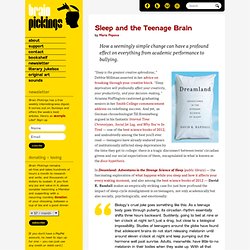
“Sleep is the greatest creative aphrodisiac,” Debbie Millman asserted in her advice on breaking through your creative block. “Sleep deprivation will profoundly affect your creativity, your productivity, and your decision-making,” Arianna Huffington cautioned graduating seniors in her Smith College commencement address on redefining success. And yet, as German chronobiologist Till Roenneberg argued in his fantastic Internal Time: Chronotypes, Social Jet Lag, and Why You’re So Tired — one of the best science books of 2012, and undoubtedly among the best you’ll ever read — teenagers have already endured years of institutionally inflicted sleep deprivation by the time they get to college: there is a tragic disconnect between teens’ circadian givens and our social expectations of them, encapsulated in what is known as the disco hypothesis.
Donating = Loving. Tarkovsky's advice to the young: Learn to enjoy your own company. The Art of “Creative Sleep”: Stephen King on Writing and Wakeful Dreaming. By Maria Popova “In both writing and sleeping, we learn to be physically still at the same time we are encouraging our minds to unlock from the humdrum rational thinking of our daytime lives.” “Sleep is the greatest creative aphrodisiac,” a wise woman once said. Indeed, we already know that dreaming regulates our negative emotions and “positive constructive daydreaming” enhances our creativity, while a misaligned sleep cycle is enormously mentally crippling. But can a sleep-like state in waking life, aside from lucid dreaming, actually enrich and empower our creative capacity? According to Stephen King, yes: In On Writing: A Memoir on the Craft (public library), which also gave us his case against adverbs, the celebrated novelist explores the similarity between writing and dreaming.
Like your bedroom, your writing room should be private, a place where you go to dream. King likens the creative process to a kind of wakeful dream state. Donating = Loving. The Best of Brain Pickings 2013. The Ego and the Universe: Alan Watts on Becoming Who You Really Are. By Maria Popova. The History of the English Language, Animated. The Human Body: What It Is and How It Works, in Vibrant Vintage Illustrations... By Maria Popova “Two hearts could provide enough energy to drive a truck around the world in two years.”
Much of our inquiry into what makes us human focuses on understanding consciousness, yet we spend the whole of our lives in our physical bodies. The Power of Process: What Young Mozart Teaches Us About the Secret of Cultiv... The Science of Dreams and Why We Have Nightmares. The Science of Stress, Orgasm and Creativity: How the Brain and the Vagina Co... “The more closely we analyze what we consider ‘sexy,’” philosopher Alain de Botton argued in his meditation on sex, “the more clearly we will understand that eroticism is the feeling of excitement we experience at finding another human being who shares our values and our sense of the meaning of existence.”
The Secret of Life from Steve Jobs in 46 Seconds. The Universe in a Glass of Wine: Richard Feynman on How Everything Connects, ... What Happens While You Sleep and How It Affects Your Every Waking Moment. By Maria Popova “We are living in an age when sleep is more comfortable than ever and yet more elusive.” The Ancient Greeks believed that one fell asleep when the brain filled with blood and awakened once it drained back out. Nineteenth-century philosophers contended that sleep happened when the brain was emptied of ambitions and stimulating thoughts. “If sleep doesn’t serve an absolutely vital function, it is the greatest mistake evolution ever made,” biologist Allan Rechtschaffen once remarked. Even today, sleep remains one of the most poorly understood human biological functions, despite some recent strides in understanding the “social jetlag” of our internal clocks and the relationship between dreaming and depression. Why Pink Doesn’t Exist: An Illustrated Stop-Motion Science Explanation in 60 ...
Zentangle: Pattern-Drawing as Meditation. By Maria Popova If greater creativity and more mental balance are among your new year’s resolutions, look no further than Zentangle — a type of meditation achieved through pattern-making, created by artist duo Maria Thomas and Rick Roberts. Each pattern is built one line at a time, organically combining simple patterns into complex zentangles in unplanned, unexpected ways that grow, change and unfold on the page as you enter an immersive state of flow.
Totally Tangled offers a fantastic introduction to the relaxing and beautiful practice through step-by-step instructions and over 100 original tangles. We’re particularly taken with Zentagle because its basic principle — building on simple shapes and combining different patterns into complex creativity — is such a beautiful visual metaphor for our core philosophy of combinatorial creativity.